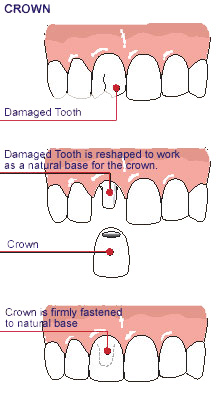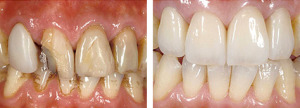A dental crown is a tooth-shaped “cap” that is placed over a tooth — to cover the tooth to restore its shape and size, strength, and improve its appearance.
The crowns, when cemented into place, fully encase the entire visible portion of a tooth that lies at and above the gum line.
Why Is a Dental Crown Needed
A dental crown may be needed in the following situations:
To protect a weak tooth (for instance, from decay) from breaking or to hold together parts of a cracked tooth
To restore an already broken tooth or a tooth that has been severely worn down
To cover and support a tooth with a large filling when there isn’t a lot of tooth left
To hold a dental bridge in place
To cover misshapened or severely discolored teeth
To cover a dental implant
To make a cosmetic modification
What Types of Crowns Are Available?
Crowns can be made of porcelain, metal, or both. Porcelain crowns are most often preferred because they mimic the translucency of natural teeth and are very strong.
Metals used in crowns include gold alloy,or a base-metal alloy (for example, nickel or chromium). Compared with other crown types, less tooth structure needs to be removed with metal crowns, and tooth wear to opposing teeth is kept to a minimum. Metal crowns withstand biting and chewing forces well and probably last the longest in terms of wear down. Also, metal crowns rarely chip or break. The metallic color is the main drawback. Metal crowns are a good choice for out-of-sight molars.
Porcelain-fused-to-metal dental crowns can be color matched to your adjacent teeth (unlike the metallic crowns)Next to all-ceramic crowns, porcelain-fused-to-metal crowns look most like normal teeth. These crowns can be a good choice for front or back teeth.
All-ceramic or all-porcelain dental crowns provide better natural color match than any other crown type All-ceramic crowns are a good choice for front teeth.
What steps Are Involved in Placing a Crown for the teeth
usually it requires two visits to the dentist — the first step involves examining and preparing the tooth, the second visit involves placement of the permanent crown.

Step 1: First visit – Examining and preparing the tooth.
At the first visit in preparation for a crown, your dentist may take a few X-rays to check the roots of the tooth receiving the crown and surrounding bone. If the tooth has extensive decay or if there is a risk of infection or injury to the tooth’s pulp, a root canal treatment may first be performed.
Before the process of making a crown begins, your dentist will anesthetize (numb) the tooth and the gum tissue around the tooth. Next, the tooth receiving the crown is filed down along the chewing surface and sides to make room for the crown. The amount removed depends on the type of crown used (for instance, all-metal crowns are thinner and require less tooth structure removal than all-porcelain or porcelain-fused-to-metal ones). If, on the other hand, a large area of the tooth is missing (due to decay or damage), your dentist will use filling material to “build up” the tooth to support the crown.
After reshaping the tooth, your dentist will use a paste or putty to make an impression of the tooth to receive the crown. Impressions of the teeth above and below the tooth to receive the dental crown will also be made to make sure that the crown will not affect your bite.
The impressions are sent to a dental lab where the crown will be manufactured. The crown is usually returned to your dentist’s within a week. If the crown is made of porcelain, your dentist will also select the shade that most closely matches the color of the neighboring teeth. During this first office visit your dentist will make a temporary crown to cover and protect the prepared tooth while the crown is being made. Temporary crowns usually are made of acrylic and are held in place using a temporary cement
Step 2:Second Visit – Receiving the permanent dental crown.
At the second visit, your dentist will remove the temporary crown and check the fit and color of the permanent crown. If everything is acceptable,the new crown is permanently cemented in place.

How Long Do Dental Crowns Last?
On average, dental crowns last between five and 15 years. The life span of a crown depends on the amount of “wear and tear” the crown is exposed to, how well you follow good oral hygiene practices, and your personal mouth-related habits (you should avoid such habits as grinding or clenching your teeth,biting fingernails, and using your teeth to open packaging).
Does a Crowned Tooth Require Special Care?
While a crowned tooth does not require any special care, remember that simply because a tooth is crowned does not mean the tooth is protected from decay or gum disease. Therefore, continue to follow good oral hygiene practices, including brushing your teeth at least twice a day and flossing once a day — especially around the crown area where the gum meets the tooth. Antibacterial mouth rinse can also help.
